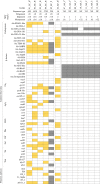Prevalence of carbapenem resistance and its potential association with antimicrobial use in humans and animals in rural communities in Vietnam
- PMID: 35449721
- PMCID: PMC9018397
- DOI: 10.1093/jacamr/dlac038
Prevalence of carbapenem resistance and its potential association with antimicrobial use in humans and animals in rural communities in Vietnam
Abstract
Background: Vietnam and Southeast Asia are hotspots for antimicrobial resistance; however, little is known on the prevalence of carriage of carbapenem resistance in non-hospitalized humans and in animals. Carbapenem-resistant Enterobacteriaceae (CRE), particularly Escherichia coli (CREC) and Klebsiella pneumoniae (CRKP) and also Acinetobacter baumannii (CRAB) are emerging threats worldwide.
Methods: We investigated healthy humans (n = 652), chickens (n = 237), ducks (n = 150) and pigs (n = 143) in 400 small-scale farms in the Mekong Delta of Vietnam. Samples (rectal swabs, faecal swabs) were investigated for carriage of CRE/CRAB and were further characterized phenotypically and genotypically.
Results: In the Mekong Delta of Vietnam, the prevalence of CRE isolates in human rectal swabs was 0.6%, including 4 CREC and 1 CRKP. One pig was infected with CREC (prevalence 0.7%). CRAB was isolated from chickens (n = 4) (prevalence 2.1%) and one duck (prevalence 0.7%). CRKP was isolated from a human who was also colonized with CREC. The CRKP strain (ST16), from an 80 year-old person with pneumonia under antimicrobial treatment, genetically clustered with clinical strains isolated in a hospital outbreak in southern Vietnam. The prevalence of CRE was higher among humans that had used antimicrobials within 90 days of the sampling date than those had not (4.2% versus 0.2%) (P = 0.005). All CRE/CRAB strains were MDR, although they were susceptible to colistin and neomycin. The carbapenemase genes identified in study strains were bla NDM and bla OXA.
Conclusions: The finding of a CRKP strain clustering with previous hospital outbreak raises concerns about potential transmission of carbapenem-resistant organisms from hospital to community settings or vice-versa.
© The Author(s) 2022. Published by Oxford University Press on behalf of British Society for Antimicrobial Chemotherapy.
Figures



Similar articles
-
Molecular and clinical epidemiology of carbapenem resistant Acinetobacter baumannii, Pseudomonas aeruginosa and Enterobacterales in Fiji: a multicentre prospective observational study.Lancet Reg Health West Pac. 2024 May 29;47:101095. doi: 10.1016/j.lanwpc.2024.101095. eCollection 2024 Jun. Lancet Reg Health West Pac. 2024. PMID: 38867891 Free PMC article.
-
A comparative study of genotyping and antimicrobial resistance between carbapenem-resistant Klebsiella pneumoniae and Acinetobacter baumannii isolates at a tertiary pediatric hospital in China.Front Cell Infect Microbiol. 2024 Mar 8;14:1298202. doi: 10.3389/fcimb.2024.1298202. eCollection 2024. Front Cell Infect Microbiol. 2024. PMID: 38524181 Free PMC article.
-
Carbapenem-resistant hypermucoviscous Klebsiella pneumoniae clinical isolates from a tertiary hospital in China: Antimicrobial susceptibility, resistance phenotype, epidemiological characteristics, microbial virulence, and risk factors.Front Cell Infect Microbiol. 2022 Dec 21;12:1083009. doi: 10.3389/fcimb.2022.1083009. eCollection 2022. Front Cell Infect Microbiol. 2022. PMID: 36619764 Free PMC article.
-
Molecular characterization of carbapenem-resistant Enterobacteriaceae and emergence of tigecycline non-susceptible strains in the Henan province in China: a multicentrer study.J Med Microbiol. 2021 Mar;70(3):001325. doi: 10.1099/jmm.0.001325. Epub 2021 Feb 15. J Med Microbiol. 2021. PMID: 33587030 Free PMC article.
-
Clinical carbapenem-resistant Klebsiella pneumoniae isolates simultaneously harboring bla NDM-1, bla OXA types and qnrS genes from the Kingdom of Bahrain: Resistance profile and genetic environment.Front Cell Infect Microbiol. 2022 Oct 11;12:1033305. doi: 10.3389/fcimb.2022.1033305. eCollection 2022. Front Cell Infect Microbiol. 2022. PMID: 36304935 Free PMC article.
Cited by
-
Whole Genome Sequencing and Molecular Analysis of Carbapenemase-Producing Escherichia coli from Intestinal Carriage in Elderly Inpatients.Microorganisms. 2022 Aug 3;10(8):1561. doi: 10.3390/microorganisms10081561. Microorganisms. 2022. PMID: 36013979 Free PMC article.
-
Genomic epidemiology and resistant genes of Acinetobacter baumannii clinical strains in Vietnamese hospitals.J Med Microbiol. 2024 Oct;73(10):001922. doi: 10.1099/jmm.0.001922. J Med Microbiol. 2024. PMID: 39475466 Free PMC article.
-
A systematic review and meta-analysis of integrated studies on antimicrobial resistance in Vietnam, with a focus on Enterobacteriaceae, from a One Health perspective.One Health. 2022 Nov 19;15:100465. doi: 10.1016/j.onehlt.2022.100465. eCollection 2022 Dec. One Health. 2022. PMID: 36561710 Free PMC article. Review.
-
Genomic characterization of carbapenem and colistin-resistant Klebsiella pneumoniae isolates from humans and dogs.Front Vet Sci. 2024 May 21;11:1386496. doi: 10.3389/fvets.2024.1386496. eCollection 2024. Front Vet Sci. 2024. PMID: 38835891 Free PMC article.
-
Prevalence and molecular epidemiology of carbapenem resistance in Asia: a systematic review and meta-analysis.Syst Rev. 2025 Jun 5;14(1):123. doi: 10.1186/s13643-025-02776-5. Syst Rev. 2025. PMID: 40474248 Free PMC article.
References
-
- WHO . WHO list of critically important antimicrobials for human medicine, 6th revision. 2018. https://www.who.int/publications/i/item/9789241515528.
-
- WHO . Global priority list of antibiotic-resistant bacteria to guide research, discovery, and development of new antibiotics. 2017. https://www.who.int/medicines/publications/WHO-PPL-Short_Summary_25Feb-E....
-
- Higgins PG, Dammhayn C, Hackel Met al. . Global spread of carbapenem-resistant Acinetobacter baumannii. J Antimicrob Chemother 2010; 65: 233–8. - PubMed
Grants and funding
LinkOut - more resources
Full Text Sources
